Bussana Vecchia: The battle over Italy's eclectic, handbuilt village
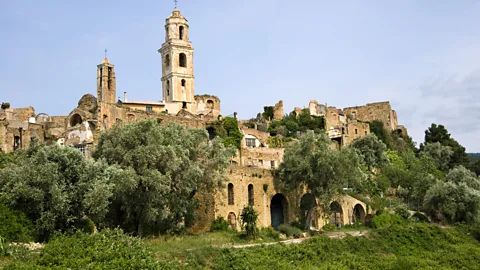 Getty Images
Getty ImagesAfter a Ligurian hilltop village was destroyed by an earthquake, a group of artists rebuilt from the ruins. Now residents of this popular tourist attraction are facing eviction.
I'm standing outside the puppet maker's house in the Italian medieval village of Bussana Vecchia. It's raining, and the narrow street is utterly silent, the cobblestones glinting in the yellow light emanating from the glass door in front of me.
The door opens, and Nina Franco beams at me. "Come in! Come in!" She's dressed in paint-spotted blue workman's overalls and a scarf is tied over her hair. Inside this space, which doubles as her workshop, felt hand-puppets and varnished wooden marionettes spill out of wooden crates and hang from nets attached to the ceiling, crowded next to miniature theatres and commedia dell'arte characters.
Peeking past Franco, I can see that the back of the building is still a work in progress, with piles of rocks in lieu of a kitchen floor. She sees my gaze and laughs: "I'm still building! Everyone in this village at some point or other has had to build their own house."
Franco is one of Bussana Vecchia's newest residents. She arrived in 2022 after spending 20 years living in Argentina and joined the village's eclectic community of international artists. "It's a real tower of Babel. If you close your eyes, you can hear French, German, Russian, Spanish – all from people who live here," she tells me over tea as we sit on a rug on her floor and talk about the village's history.
Bussana Vecchia is a peculiar character in the lineup of chic resort towns that adorn the coast of the Italian Riviera. It clings to the top of one of the hills bunched above Sanremo, and the latest chapter in its long history begins with a disaster.
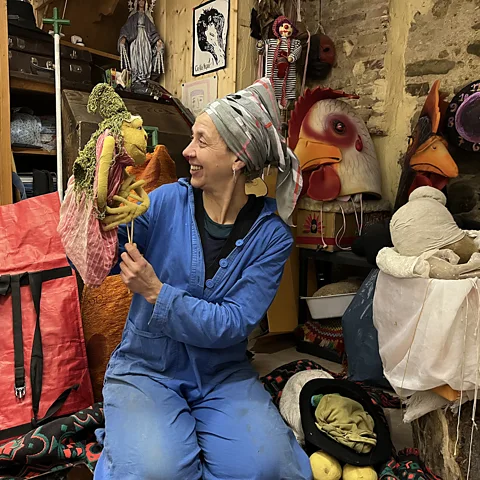 Catherine Bennett
Catherine BennettIt was dawn on the first day of Lent, 23 February 1887. Many of Bussana's residents were in church, taking mass before a day of work in the fields. Just as the priest had smudged ashes onto the forehead of his last parishioner, so the story goes, there was a terrible shaking in the air and the ground moved beneath their feet. A second quake five minutes later made the thick stone roof of the church give way and crash to the ground.
The earthquake that struck along the northern Ligurian coast that day destroyed the upper section of the village, killing people in their beds as their roofs collapsed on them. A total of 53 people died – their names are listed on a marble plaque at the entrance to the village. Sepia photographs from the time show rows of wooden barracks constructed lower down the hill to house refugees, where they ended up living for seven long years, metres from their old home. The promised rebuilding never came. The first stone for Bussana Nuova – the new village down the hill – was laid two years later, and the original town was definitively abandoned in 1894.
The years passed, and Bussana Vecchia (Old Bussana) turned into a ghost town. Smugglers used it to store contraband before crossing over into France, and immigrants from southern Italy moved in for a time. Each time, these residents were forcibly evicted by local authorities.
The turning point happened at the end of the 1950s. A ceramist from Turin, Mario Giani, known as Clizia, had the idea of turning it into an artists' commune. Little by little, more artists followed him from across Europe, drawn by the idyll of a place with no rules, where you built your own house by hand out of the rubble and spent your days making art.
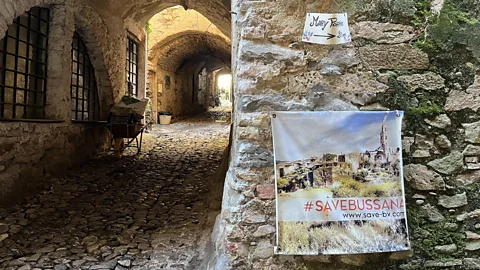 Catherine Bennett
Catherine Bennett"I can still remember the smell of it back then," says Erminia Pascucci, a long-time resident, when I meet her in her cosy apartment. Pascucci first came to Bussana Vecchia in 1974 when she was 22 years old. "We had two wells where we got water, but you could only use it for cleaning. You went to the nearby town of Arma di Taggia once a week to have a shower. We used oil lamps and candles. Maybe that was part of the fascination we had with the place – it was life pared back to its essentials."
How to visit
- You can visit Bussana Vecchia as a day trip from other Ligurian towns like Sanremo or Genova. The best time is in summer, when former residents come back to visit family and friends and the village’s population doubles. At this time of year, you might be lucky enough to catch a concert or party in one of the abandoned buildings.
- It’s easiest to visit by car as there’s no public transport directly to the village. If you don't mind working up a sweat, there’s a steep but beautiful hiking trail from Bussana Nuova.
- While you’re there, check out the galleries and buy some art to take home before relaxing with a spritz in Piazzetta Golosa.
- The Osteria degli Artisti is the village’s oldest restaurant. It serves up Ligurian specialties at fair prices – but book in advance if you’re coming in the high season.
She gestures around her at the curved, whitewashed walls of her home. "You fall in love with these stones."
Bussana openly wears its wounds from the earthquake. Some of the medieval houses are boarded up, crumbling like a biscuit at the edges, whereas others have flowers freshly planted in pots and colourful curtains in the windows, children's bikes leaning against a side door. There's a playful atmosphere, as though the village were in continual preparation for a fete. The imprint of the artists is everywhere: shards of colourful tile run across a wall; paintings decorate the streets; and sculptures made of twisted wire, clay or found materials are hidden around the town like Easter eggs. The still-roofless church is overgrown with grass and weeds now, and pigeons cluster in its fresco-covered arches.
The place has changed since those heady, hippy days. It's no longer off the grid, and now has electricity, running water and, of course, Airbnbs. There are several restaurants and a local bar that does brisk business at weekends serving spritzes to French and German tourists. Many of the artists have relented and sell fridge magnets alongside their artwork. The town has become another pole of attraction for the area, alongside the beach resorts and nearby Sanremo, with its music festival and casino.
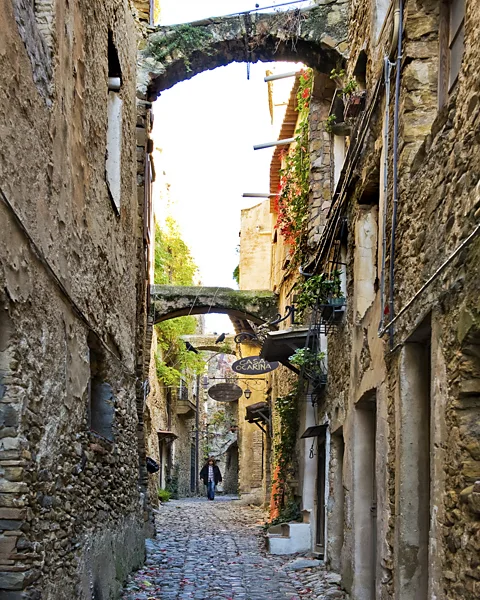 Getty Images
Getty ImagesDespite Bussana Vecchia's popularity – or perhaps because of it, as some residents believe – the authorities are threatening the villagers with eviction.
In 2017 residents received letters informing them that they had no legal right to their houses and were considered illegal squatters by the state. In response, people in the village banded together to form a collective, calling themselves i Resilienti (the Resilients).
The collective is currently in a tug-of-war with the regional authorities and the state property department. Residents want to be recognised as the rightful owners of houses that they rebuilt themselves. The authorities initially wanted residents to pay fines to the state for illegally occupying the houses, but that was struck down in a ruling by the Council of State in June 2024. The Sanremo municipality has come up with various suggestions to solve the impasse, including running a public auction so that villagers can bid on their own houses (although they risk being outbid and losing their home).
"It's a whole contradiction. The municipality is saying, 'Visit Bussana Vecchia, the beautiful artists' village!' But then at the same time they're waging war on us," says Pascucci.
The regional mayor said that restoration plans are an "unmissable opportunity" to turn the village into a "jewel" that is "finally accessible in total safety". Andrea Zammatoro, who grew up in Bussana Vecchia, snorts at the idea that the village isn't safe.
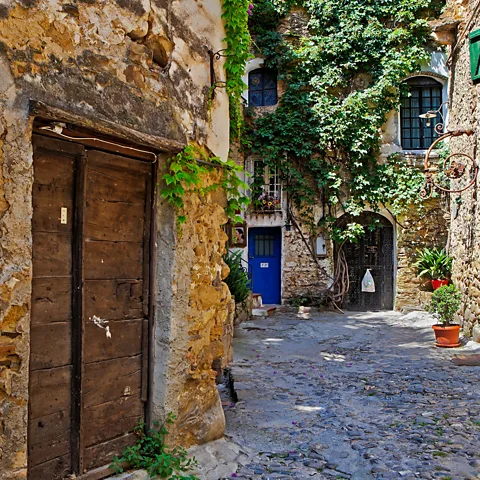 Alamy
Alamy"Probably the worst accident that there's been in this village happened to me!" he says. "When I was eight years old, I was playing in the ruined church when a stone fell on my face and broke my nose. This is the only reason the state is concerned – they don't want to spend thousands of euros in compensation to a tourist who was hurt here." Like many residents, he's worried that if the authorities gain control, the village will turn into a tourist trap and lose its bohemian spirit.
Even the villagers are divided. Some want to be granted property rights. Others are happy to get a "concession" – the right to spend the rest of their lives in their houses, in exchange for a symbolic annual rent paid to the regional authorities. Negotiations have been going on for years. The collective fears that the state will take each resident to court to evict them – effectively picking them off one by one.
Because of the standoff, €15m of European recovery funds that would have gone to the restoration of the village went instead to Sanremo. Not that the residents mind – they're used to the junkyard feel of the village, the tangle of cables and wires on the outsides of houses, the leaking roofs that they patch up themselves. What they're trying to protect is a lot less tangible – it's the spirit of open-mindedness and freedom that has defined life in the village for the past 60 years.
--
If you liked this story, sign up for The Essential List newsletter – a handpicked selection of features, videos and can't-miss news, delivered to your inbox twice a week.
